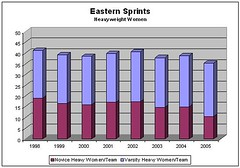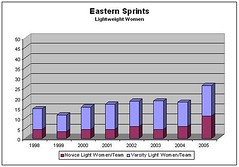Novice Rowing and the NCAA
You may recall that a few weeks ago a reader wrote with the suggestion that freshmen lightweight boats be all novices and that recruits or otherwise experienced rowers row with the varsity. This would hopefully have the effect of providing a much-needed 2V and keep more walk-ons rowing. This reader also contended that by racing only two eights and a four at its championship, the NCAA is killing off novice racing, and to prove that sent some statistics from Eastern Sprints.
The charts below (click for a larger size) show the average number of women per team, for both heavyweights and lightweights, competing at the Eastern Sprints. The first chart is heavyweight women. You'll notice that with the exception of a slight upward blip in 2001 and 2002 novice participation has fallen steadily since the NCAA championship began (1997).
Conversely, the next chart shows that with the exception of a downward blip in 2003 lightweight novice participation has grown steadily. 
Because novices aren't raced at NCAAs there is less incentive for heavyweight coaches to develop and race novice boats. In a sport like rowing, where many (most, really) athletes learn the sport in college, novice competitions are particularly important. Over time, we can expect more emphasis on recruits who can impact the varsity immediately, and less on walk-ons.
Once again, this shows a fundamental misunderstanding of the nature and traditions of rowing by the NCAA. Much of the odd writing about rowing we see coming out of school athletic sites is rooted in the NCAA's belief that rowing is a "team" (meaning all boats, all levels) sport. For example, the headlines that proclaim Slide U. beats Oar College 3 - 2. The notion that you total up races won and races lost to get a regatta winner is just silly, but that's NCAA style thinking.
By the way, when you look at the lightweight chart, it's great to see how lightweight rowing at Sprints has grown. While it might not be dramatic, it is a steady climb, even as the heavyweights have been steady or shown a slight decline.

2 comments:
Hmm, I'm not sure that these data support this contention. It would be important to compare differences for the decade prior to the inception of the NCAA championshp as the only significant (not statistically speaking, but from straight eyeballing) that I see is the difference between novices in 2005 and the other years, otherwise, I see general variation in Novice participation that ranges from 17 to 14. That really isn't that much variation.
Again, the variation in lightweights is somewhat similar, ranging from 3 novices in 1999 to 5 in 2004. The greatest increase is in 2005.
Without comparable data prior to the beginning of the NCAA championship and given the apparant random variation, I think that these data are a stretch for this argument. However, seeing the raw data might be more conclusive. I am just eyeballing it.
Second, I also think that by comparing light and heavy programs in this manner is much like comparing apples to oranges. Part of the reason that lightweight women's rowing can handle so many walk-ons is that many lightweight women's programs are not traditionally thought of as "recruiting" rowing programs. The club status, rather than varsity status of some these programs means that a higher percentage of "novice" rowing will occur. Thus, it seems that it would be useful to control for this difference in the data. For example, Harvard and Yale recruit for both men's lightweight and heavyweight rowing (no NCAA race in this argument, but let's pretend.) If the NCAA race occurred only for the heavy men's programs in those two schools, and was the only difference in the styles of the programs with regards to recruitment, funding, etc., and the data indicated that the lightweight walk-on rates were higher than for the heavy-weights, then I could see support for the argument that the NCAA contributed to lower rates of walk-ons.
To me, the driving force on the decreased rates of walk-ons at large women's open-weight programs, is the switch from club to varsity status, and of course, much of this was tied to NCAA status. This may decrease collegiate walk-ons making the top boats, but it has led to an explosion in girl's junior rowing programs across the country. Wouldn't that have the same benefit?
Again, I am left wondering if novice (meaning walk-on) collegiate rowing is the point of D1 rowing programs or is fielding the best possible team? Having to train straight and total novices is very different than taking experienced freshman rowers and teaching them how to row correctly.
I agree that the data are a bit weak, but I think still enough to draw a conclusion. Of course, it would only take a few years of increased novice participation to throw this the other way. I'm not as concerned about your control problem because the lightweight programs at Sprints are mostly varsity programs that recruit. In addition, "novices" here includes anyone who rowed as a novice, whether they were recruits or not. The numbers really show rowers competing in novice events, not rowers who are true novices. Every year the core is Princeton, Radcliffe, Wisconsin, and Georgetown, with MIT the next most frequent team. Virginia was there two years when it had varsity lightweights and Brown was there two years. The other crews are Bucknell, Marist, GW, Vassar, William and Mary, and RPI.
The numbers would help. In 1998 there were 19.1 heavy women per team, while in 2005 there were 10.4. For light women the numbers are 4.5 to 11.0.
I agree that Title IX has increased the number of women rowing at the junior level, but I think the lament here is the loss of novice rowing as an event, not so much fewer freshman women rowing. Whether this is something to care about or not is arguable, but I don't think the NCAA had any idea that this would result from their championship scheme. They probably had no idea because they had no idea of the tradition.
I believe that the point of college rowing is to field the fastest possible varsity eight. To do this, particularly in lightweight rowing, walk-ons are important. In the absence of novice races it makes it harder to recruit and keep walk-ons because they get all the work (training) but none of the fun (racing) until they are upperclassmen and can vie for a varsity boat. There may one day be enough heavyweight junior rowers to meet the demand for heavyweight college rowers, but that day for lightweights is much farther off, if it will come at all.
Post a Comment